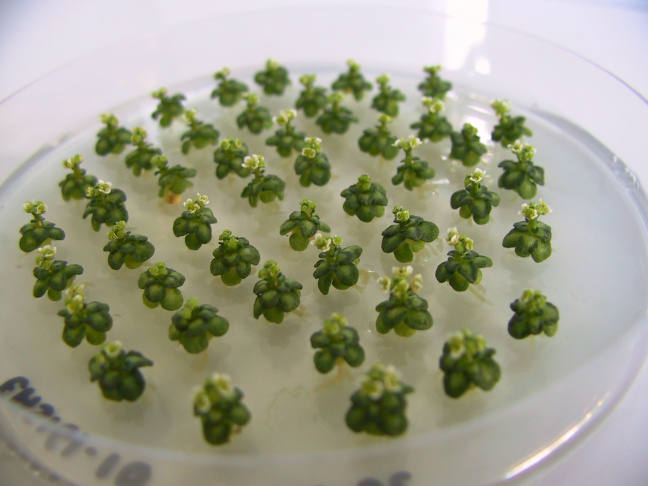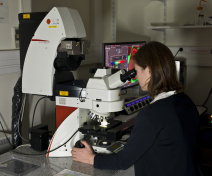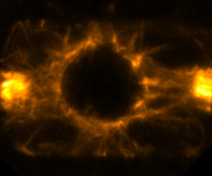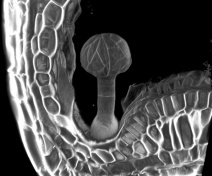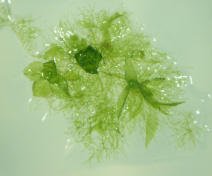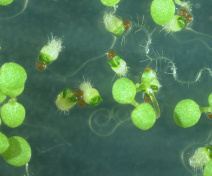The SPACE team focuses on the spatial control of cell division, elongation and differentiation in plant cells, in relation to the organization and dynamics of the microtubular cytoskeleton.
Our aims are to identify the regulation networks involved, their link with the cell cycle and their significance for land plant morphogenesis and evolution.
Biological Question
The colonization of land by green plants, about 500 million years ago, is a key event in the history of life on Earth. Adaptations to the aerial/terrestrial environment include several cellular features, like for instance the semi-rigid cellulosic cell-wall and a number of specific microtubule arrays involved in cell division, elongation and differentiation.
In land plants, fine control of division geometry is of paramount importance, since in the absence of any cell motility, this -together with cell expansion- determines the 3-dimensional cellular organization of plant tissues. During their evolutionary history, land plants have acquired specific mechanisms and microtubule arrays that allow a strict control of the division and elongation axes, both during multicellular development and in response to environmental constraints.
Our objectives are to determine the regulation pathways involved in the spatial control of cell division, elongation and differentiation, their link with the cell cycle, and their significance for land plant morphogenesis and evolution.
The colonization of land by green plants, about 500 million years ago, is a key event in the history of life on Earth. Adaptations to the aerial/terrestrial environment include several cellular features, like for instance the semi-rigid cellulosic cell-wall and a number of specific microtubule arrays involved in cell division, elongation and differentiation.
In land plants, fine control of division geometry is of paramount importance, since in the absence of any cell motility, this -together with cell expansion- determines the 3-dimensional cellular organization of plant tissues. During their evolutionary history, land plants have acquired specific mechanisms and microtubule arrays that allow a strict control of the division and elongation axes, both during multicellular development and in response to environmental constraints.
Our objectives are to determine the regulation pathways involved in the spatial control of cell division, elongation and differentiation, their link with the cell cycle, and their significance for land plant morphogenesis and evolution.
Models, tools and methods
The SPACE group mobilizes a wide spectrum of approaches: genetics, molecular biology, cytology/microscopy, microfluidics and modeling. Our main biological model is Arabidopsis thaliana, a model of choice for fundamental research in plants.
The SPACE group mobilizes a wide spectrum of approaches: genetics, molecular biology, cytology/microscopy, microfluidics and modeling. Our main biological model is Arabidopsis thaliana, a model of choice for fundamental research in plants.
Societal and economical impacts
The regulation pathways under study spatially control cell division and expansion, therefore they play an important role in morphogenesis and organogenesis throughout plant development, from embryogenesis to maturity and reproduction.
In the last years, a number of studies showed that these pathways underly a number of important traits in crop plants, like fruit/seed shape, yield, etc in a variety of species like cereals (rice, wheat), Solanaceae (tomato, potato) or cucurbits (melon, zucchini). This confirms the central role of these processes in plant morphogenesis and their importance for plant breeding and agriculture.
The regulation pathways under study spatially control cell division and expansion, therefore they play an important role in morphogenesis and organogenesis throughout plant development, from embryogenesis to maturity and reproduction.
In the last years, a number of studies showed that these pathways underly a number of important traits in crop plants, like fruit/seed shape, yield, etc in a variety of species like cereals (rice, wheat), Solanaceae (tomato, potato) or cucurbits (melon, zucchini). This confirms the central role of these processes in plant morphogenesis and their importance for plant breeding and agriculture.
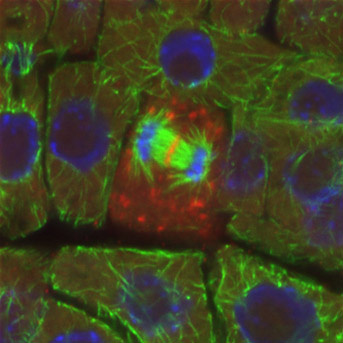
Leader:
David Bouchez
